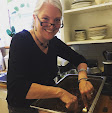
This latest essay from contributor Anthony Boutard of Ayers Creek Farm describes the relationships, informal and collegial, that exist between farmers, suppliers and, yes, even bureaucracies.
We buttoned up the Hot Lips harvest [Ayers Creek supplies berries for their sodas. - KAB] on Monday, and shifted our attention to packing blackberries for Sweet Creek Foods. Run by Paul and Judy Fuller, Sweet Creek is a small processing facility located in Elmira, west of Eugene. They source everything they can locally, and also allow farms such as ours to use the facility. Without Paul and Judy, we would not be able to produce our preserves. They also work work with a host of other farms in the valley. On Wednesday, when we went down to collect empty buckets and move some fruit into their freezer, Paul had just returned from the coast with a load of tuna.
 The trip to Elmira takes us down 99W, and is a spectacular trip. On Wednesday, the last burning of the south valley grass seed field was taking place, for better or worse. From now on, only a small area of fescue production in the Santiam Hills will continue the annual rite.
The trip to Elmira takes us down 99W, and is a spectacular trip. On Wednesday, the last burning of the south valley grass seed field was taking place, for better or worse. From now on, only a small area of fescue production in the Santiam Hills will continue the annual rite.Seed production is a vital part of the valley's agriculture, and many seed houses have offices in Brownsville. The list of seeds grown in the valley is more extensive than simply grasses. You may pass a quarter section planted to coriander, cabbage, beets or turnips. The passerby may wonder why a whole field of squash has been wastefully left unharvested when, in fact, it is being grown as a seed crop. In a seed production area, it is vitally important for producers, even as competitors, to know where everything is planted in order to avoid cross pollination. Similar crops, for example turnips, need to be isolated from one another by as much as two miles to keep the seed crop pure. For wind pollinated plants such as corn and beets, the isolation distance is greater.
 To administer the seed production area, the extension office maintains a "pinning map" (right). The seed companies literally take a pin which has a small card with the seed type and variety being produced attached to it, and pokes it into the property where they will pant the crop. It is an honor system based on years of custom and collegiality.
To administer the seed production area, the extension office maintains a "pinning map" (right). The seed companies literally take a pin which has a small card with the seed type and variety being produced attached to it, and pokes it into the property where they will pant the crop. It is an honor system based on years of custom and collegiality.Yesterday, we filled the van with the buckets of freshly harvested blackberries and called Paul to tell him the van was on the road. He leaves Elmira at the same time, and we transfer the fruit when we meet, usually around Monmouth if traffic is light. If all goes well, we will complete Sweet Creek's order next Friday. We will next see Paul and Judy when we process our preserves in late October. The fields will have greened up from the autumn rains and big leaf maples will glow among the dark firs.
Photo, top, by Jen McCabe for The Oregonian. Pinning map by Lindsey du Toit, Washington State University.








No comments:
Post a Comment